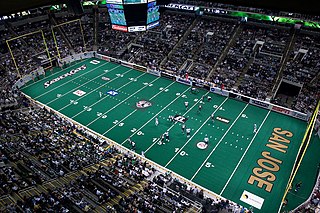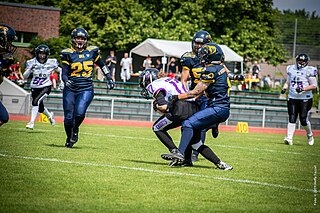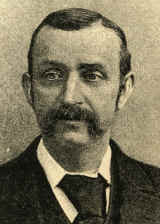
Canadian football, or simply football, is a sport in Canada in which two teams of 12 players each compete on a field 110 yards (101 m) long and 65 yards (59 m) wide, attempting to advance a pointed oval-shaped ball into the opposing team's end zone.

Arena football is a variety of eight-man indoor gridiron football. The game is played indoors on a smaller field than American or Canadian football, designed to fit in the same surface area as a standard North American ice hockey rink, resulting in a faster and higher-scoring game that can be played on the floors of indoor arenas. The sport was invented in 1981, and patented in 1987, by Jim Foster, a former executive of the National Football League and the United States Football League. The name is trademarked by Gridiron Enterprises and had a proprietary format until its patent expired in 2007.
Overtime or extra time is an additional period of play specified under the rules of a sport to bring a game to a decision and avoid declaring the match a tie or draw where the scores are the same. In some sports, this extra period is played only if the game is required to have a clear winner, as in single-elimination tournaments where only one team or players can advance to the next round or win the tournament and replays are not allowed.

American and Canadian football are gridiron codes of football that are very similar; both have their origins partly in rugby football, but some key differences exist between the two codes.

Gameplay in American football consists of a series of downs, individual plays of short duration, outside of which the ball is or is not in play. These can be plays from scrimmage – passes, runs, punts or field goal attempts – or free kicks such as kickoffs and fair catch kicks. Substitutions can be made between downs, which allows for a great deal of specialization as coaches choose the players best suited for each particular situation. During a play, each team should have no more than 11 players on the field, and each of them has specific tasks assigned for that specific play.
In gridiron football, clock management is an aspect of game strategy that focuses on the game clock and/or play clock to achieve a desired result, typically near the end of a match. Depending on the game situation, clock management may entail playing in a manner that either slows or quickens the time elapsed from the game clock, to either extend the match or hasten its end. When the desired outcome is to end the match quicker, it is analogous to "running out the clock" seen in many sports. Clock management strategies are a significant part of American football, where an elaborate set of rules dictates when the game clock stops between downs, and when it continues to run.

A kickoff is a method of starting a drive in gridiron football. Additionally, it may refer to a kickoff time, the scheduled time of the first kickoff of a game. Typically, a kickoff consists of one team – the "kicking team" – kicking the ball to the opposing team – the "receiving team". The receiving team is then entitled to return the ball, i.e., attempt to advance it towards the kicking team's end zone, until the player with the ball is tackled by the kicking team, goes out of bounds, scores a touchdown, or the play is otherwise ruled dead. Kickoffs take place at the start of each half of play, the beginning of overtime in some overtime formats, and after scoring plays.
In sports strategy, running out the clock is the practice of a winning team allowing the clock to expire through a series of preselected plays, either to preserve a lead or hasten the end of a one-sided contest. Such measures expend time but do not otherwise have a tactical purpose. This is usually done by a team that is winning by a slim margin near the end of a game, in order to reduce the time available for the opposing team to score. Generally, it is the opposite strategy of running up the score.
A play clock, also called a delay-of-game timer, is a countdown clock intended to speed up the pace of the game in gridiron football. The offensive team must put the ball in play by either snapping the ball during a scrimmage down or kicking the ball during a free kick down before the time expires, or else they will be assessed a 5-yard delay of game or time count violation penalty. If a visible clock is not available or not functioning, game officials on the field will use a stopwatch or other similar device to enforce the rule.

In American football and Canadian football, a quarterback kneel, also called taking a knee, genuflect offense, kneel-down offense, or victory formation, occurs when the quarterback touches a knee to the ground immediately after receiving the snap, thus downing himself and ending the play. It is primarily used to run the clock down, either at the end of the first half or the game itself, to preserve a lead or ensure a game goes into overtime if the game is tied and in the fourth quarter. Although it generally results in a loss of some yardage and uses up a down, it minimizes the risk of a fumble, which would give the other team a chance at recovering the ball.
In most levels of professional American football, the two-minute warning is a suspension of play that occurs when two minutes remain on the game clock in each half of a game, i.e., near the end of the second and fourth quarters, and overtime. Its effect on play is similar to that of a timeout: the game clock stops and the teams gather to discuss strategy. The suspension of play is two minutes long, the same as the short two-minute intermissions between quarters within each half. Its name reflects its origins as a point in the game where the officials would inform the teams that the half was nearly over, as the official game clock was not displayed in the stadium at the time the two-minute warning was created.
A television timeout is a break in a televised live event for the purpose of television broadcasting. This allows commercial broadcasters to take an advertising break, or issue their required hourly station identification, without causing viewers to miss part of the action.
Delay of game is an action in a sports game in which a player or team deliberately stalls the game, usually with the intention of using the delay to its advantage. In some sports, the delay of game is considered an infraction if it is longer than that permitted according to the game's rules, in which case a penalty can be issued. Some sports that have a delay of game penalty are American football, Canadian football, ice hockey and association football.
In the sports of American football or Canadian football, the act of icing the kicker or freezing the kicker is the act of calling a timeout immediately prior to the snap in order to disrupt the process of kicking a field goal. The intent is to throw the kicker off of his routine and force him to feel pressure for a longer amount of time. The tactic is used at the collegiate and professional levels, although its effectiveness has not been proven.
In team sports, substitution is replacing one player with another during a match. Substitute players that are not in the starting lineup reside on the bench and are available to substitute for a starter. Later in the match, that substitute may be substituted for by another substitute or by a starter who is currently on the bench.

In gridiron football, a penalty is a sanction assessed against a team for a violation of the rules, called a foul. Officials initially signal penalties by tossing a bright yellow colored penalty flag onto the field toward or at the spot of a foul.
In gridiron football, replay review is a method of reviewing a play using cameras at various angles to determine the accuracy of the initial call of the officials. An instant replay can take place in the event of a close or otherwise controversial call, either at the request of a team's head coach or the officials themselves.
The 2010 Franklin American Mortgage Music City Bowl was the 13th edition of the college football bowl game and was played at LP Field in Nashville, Tennessee. The game was played on Thursday, December 30, 2010.

The rules of water polo are the rules and regulations which cover the play, procedure, equipment and officiating of water polo. These rules are similar throughout the world, although slight variations do occur regionally and depending on the governing body. Governing bodies of water polo include FINA, the international governing organization for the rules; the NCAA, which govern the rules for collegiate matches in the United States; the NFHS, which govern the rules in high schools in the USA; and the IOC, which govern the rules at Olympic events.











